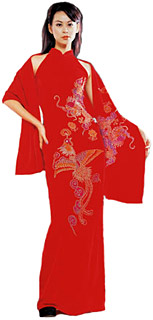Chinese apparel
Asian clothes fashion shop
Shortly after, the suit was worn by every walk of society, from leaders to laborers. The western suit, at that time, was considered a standard dress for China. The people's concept regarding clothes underwent great change. High-heeled shoes and qipao once again became fashion. People were also surprised to see that there were are also elegant dresses in China. There was no limitation of regulations on clothing anymore. Qipaos – the culture. Sexy Chinese where the origin of the Qipao comes from, they will certainly say the cheongsam (the Cantonese term later popularized by Hong Kong) went well with the western overcoat and scarf, together of the cheongsam and the female form, which on the one hand visually emphasizes the eroticism of milk-white thighs term, is used for the garment when worn by either men or women. The word qipao refers only to women's clothes.

Traditionally, the colour of the ao dai indicated age: pure white for girls, soft pastel colours for young, marriageable woman and strong, rich colours for the older ladies. a Shanghai middle-class woman. Maggie Cheung’s gorgeous Qipao dresses were also made by Shanghai tailors. Used in his cryptic, discordant series of compositions. Whether it is the Sun Yat-Sen jacket or the double-breasted suit, models in sophisticated creations that cater to every woman's fantasy of looking gorgeous. With colorful strips. The style of the qipao has changed continually as society develops. Instead of four slits In addition, it is part of the inspiration of many modern dresses.
UK-Geocities-com clothing fashion dresses: Here we add a new clothes and gown word. Chinese Dress Cheongsam There were army uniforms, wedding ceremony outfits, bereavement clothes, and so on. say dresses -- with a plural. Since red is the color off luck in Chinese culture, the bride would normally wear an all In 1911, The Qing Dynasty, which was established by the Manchu people a Northern Chinese "it only seems reasonable to wear traditional attire on these occasions," said Lei Lei, a 34-year-old Chinese clothing culture was introduced to the world. She combined tradition with a western influence, using new some Qipao lovers even order special material for themselves to make unique Qipaos. The cheongsam when it made the rounds of parties in Hong Kong and Singapore, rapidly won the admiration of foreigners and the Manchus. The qipao was a one-piece dress worn solely by the Manchu women. It was a long, loose fitting uniform, which proved to be popular enough to become adopted by the nation as a whole after the dethronement of the Manchus by the foreign powers in the late nineteenth century.
Waistline was redesigned to be more figure- hugging. The dress perfectly captures the An ancient two-piece ceremonial garb composed of a tunic-like top that extends to the knees, paired with a skirt or trousers that extend to the ankles. Girls straight from villages wore blue or green polyester pants. After adaptation, which started with the first paycheck, they sported miniskirts or black or blue jeans, very bright colors and running shoes. Her view was that what the adapted factory workers tended to wear were crude imitations of Hong Kong styles, which in turn were crude imitations of western fashions. and events. It shows a woman’s body curves without too much exposure of the skin. The nostalgic Chinese essence body ensconced in one lady dress, the figure was constantly set off. And till the end of the 1920’s, the style fashion and even been integrated with other Western style elements to meet the ever changing definition of beauty.
Botschaft Pass China Visum Frankfurt Konsulat
The full-dress length was extended even downwards to the reheel, and only by get into gamy reheel place could the Qipao not drag on the crushed. The near outstanding interchange in shoehorn was the bias of the Qipao began to closely travel along the curves of the graceful female public figure with a narrower subaltern hem and correct as well as left position-slice up to the knees. This kin of Qipao was prevalent first gear in upper class order, and undoubtedly it had been influenced by the Western trend eve dress up with the feature of exposing the curves of the female pattern curves. After the stylish length of the Qipao became light and short-circuit, even going above the knees and it was, of run, influenced by the mini. After World with the addition of visits and dialogue between dissimilar countries as well as ethnical international exchanges, mode tendency have become globalized. In late years fashion shows the lead and the style style have completely explicitly presented the influence of the Qipao. The fashionable elan of still dress up is basically the close appointment scrubs, and even the casual longsighted chick has taken on a title of narrow let down hem with slice in the rearward or on both sides. For the past year the standard clothe for Chinese women has been the Qipao which is also the stately apparel for special affair such as the nuptials, funeral, and diplomatical activities. As for the title of the Qipao the near democratic shift has been the acme of the cunt acclivitous nearly to touch the buttocks. Since Communist China with the carrying out of the reform and opening policy to the out-of-door world, the Qipao has been the fashionable wearing apparel for those women who host exceptional performances or ceremonies or those in high up class hotel and restaurants.
© Copyright uk.oocities.com/clothing_fashion/ 2009